Customer Retention in Telecommunication Sector in New Zealand
Added on 2023-04-05
26 Pages4748 Words204 Views
Running head: RESEARCH PROPOSAL
Research Proposal
Name of Student-
Student ID-
Assessment and Title-
Academic Supervisor-
Author’s Note-
Research Proposal
Name of Student-
Student ID-
Assessment and Title-
Academic Supervisor-
Author’s Note-

1RESEARCH PROPOSAL
Table of Contents
2. Organizational Context................................................................................................................1
3. Literature Review........................................................................................................................4
4. Aim and Research Question........................................................................................................8
5. Scope............................................................................................................................................9
6. Method.........................................................................................................................................9
7. Limitations.................................................................................................................................11
8. Ethical Implications...................................................................................................................12
9. Cost of Research........................................................................................................................13
10. Timeline...................................................................................................................................16
References......................................................................................................................................19
Table of Contents
2. Organizational Context................................................................................................................1
3. Literature Review........................................................................................................................4
4. Aim and Research Question........................................................................................................8
5. Scope............................................................................................................................................9
6. Method.........................................................................................................................................9
7. Limitations.................................................................................................................................11
8. Ethical Implications...................................................................................................................12
9. Cost of Research........................................................................................................................13
10. Timeline...................................................................................................................................16
References......................................................................................................................................19
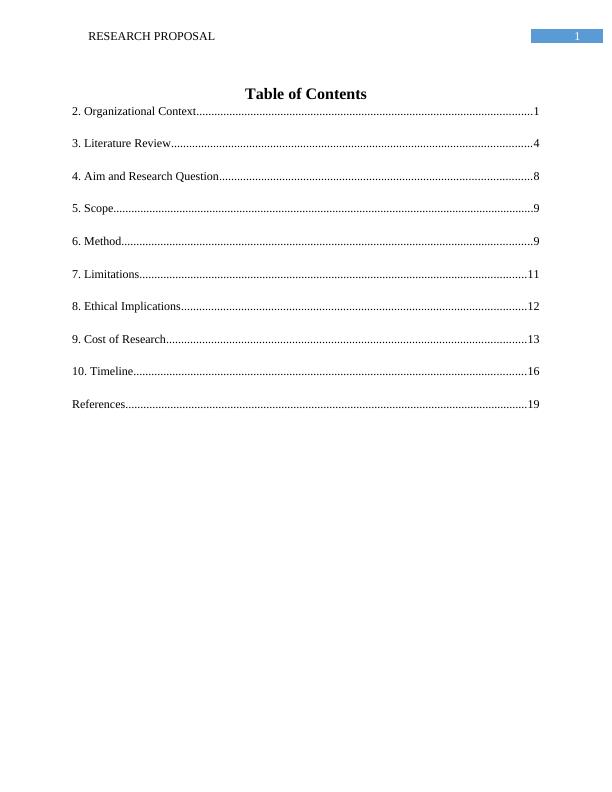
2RESEARCH PROPOSAL
1. Title: Customer Retention in Telecommunication Sector in New Zealand
2. Organizational Context
The telecommunication sectors are the primary infrastructure forms for developing the
economy of New Zealand. The telecommunication sectors of a country have the ability to
establish connection with different companies and with different countries that helps in global
communication (Giovinazzi et al., 2017). It is considered as primary because it has wide progress
in technology and has high competition. With the increasing growth of the companies in New
Zealand, the tele-communication market of the country is also increasing at tremendous way (Ott
& Michailova 2018). There are many challenges that are faced by the tele-communication
sectors related to the customer retention of the industry. There is an integrated framework that is
to be developed in the tele-communication sector that includes the opportunities for the
customers.
One of such tele-communication sector in New Zealand is the Vodafone Group. The
Vodafone group in New Zealand has many networks and operates approximately on 25 countries
over the world. Vodafone started its services in New Zealand in the year 1993 (Schröer-Merker,
Bowie & Hammond, 2016). In the year 2005, the Vodafone launched the 3G network service. In
the year 2013, Vodafone became the third largest service provider of Internet and in the year
2013, it started with the 4G service in New Zealand.
Other tele-communication companies in New Zealand are 2 Degrees, Spark and Skinny
that provides network for the people of New Zealand (Crothers et al., 2016). 2degees is a mobile
network that offers monthly rent service and has prepaid service. They also have broadband
services that the person of New Zealand uses.
1. Title: Customer Retention in Telecommunication Sector in New Zealand
2. Organizational Context
The telecommunication sectors are the primary infrastructure forms for developing the
economy of New Zealand. The telecommunication sectors of a country have the ability to
establish connection with different companies and with different countries that helps in global
communication (Giovinazzi et al., 2017). It is considered as primary because it has wide progress
in technology and has high competition. With the increasing growth of the companies in New
Zealand, the tele-communication market of the country is also increasing at tremendous way (Ott
& Michailova 2018). There are many challenges that are faced by the tele-communication
sectors related to the customer retention of the industry. There is an integrated framework that is
to be developed in the tele-communication sector that includes the opportunities for the
customers.
One of such tele-communication sector in New Zealand is the Vodafone Group. The
Vodafone group in New Zealand has many networks and operates approximately on 25 countries
over the world. Vodafone started its services in New Zealand in the year 1993 (Schröer-Merker,
Bowie & Hammond, 2016). In the year 2005, the Vodafone launched the 3G network service. In
the year 2013, Vodafone became the third largest service provider of Internet and in the year
2013, it started with the 4G service in New Zealand.
Other tele-communication companies in New Zealand are 2 Degrees, Spark and Skinny
that provides network for the people of New Zealand (Crothers et al., 2016). 2degees is a mobile
network that offers monthly rent service and has prepaid service. They also have broadband
services that the person of New Zealand uses.
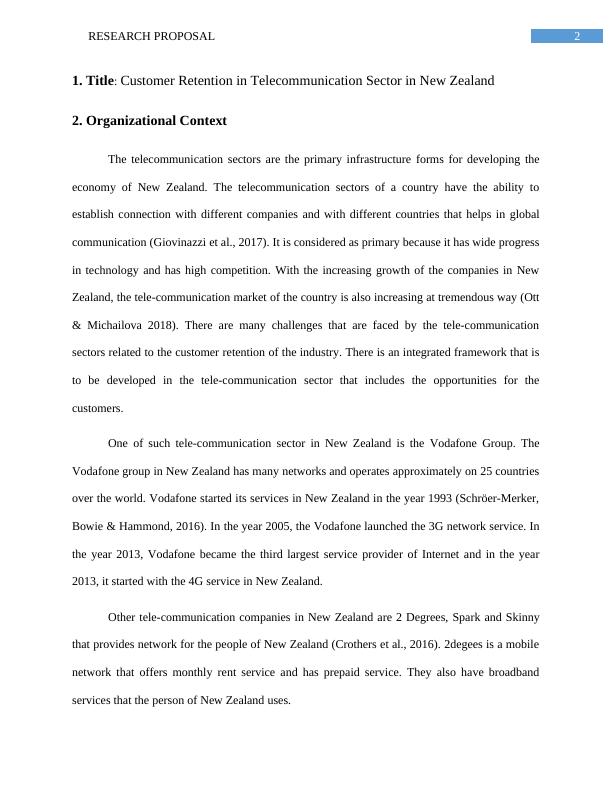
3RESEARCH PROPOSAL
Market Share: Vodafone in New Zealand added 44,000 new customers that has lifted
the mobile market share from 52.5 % to 53.7 % in a year (Ali, 2016). In the year 2006, the share
of Vodafone was higher compared to the share in December in the year 2007. The quarterly
revenue average of each user fell to 3.7 % from the previous year which was then calculated as
$49.3 million. The average monthly bill reduces from $138.50 to $122.80 in a year and the
customer bills having pre-paid connections reduced from $25.70 to $23.40 (Gul, Sarkar &
Gutierrez, 2016).
With the implementation of 2Degrees in the telecommunication market of New Zealand
in the year 2009, there were many positive market fundamentals in the business industry. This
organization attracted more than 200,000 customers in its first six months of its launch. It has
more than 1.4 million of customers holding 23 percent of the total wireless market share along
with the revenues that continues to outpace the growth of the subscriber (Hansen & Jones, 2017).
2degrees was known as Trilogy before 2008 and acquired 26% of the total tele-communication
mobile operator and renamed it as 2degrees. As per the latest data, 2Degrees have owned about
73.2% of the total market in New Zealand.
The spark and skinny had 1.38 million users in the month of May 2016 and the revenue
of the organization increased to $538.4 million to $397.6 million and according to the data of
2017 the revenue was $638.1 million.
International benefits: In the international market, Vodafone has launched a new
offerings known as Vodafone Red that will help the organization to attract more customers. The
telecom industry added that all its postpaid customers who comes under the Vodafone Red will
get benefit from the latest technology that keeps the consumer to keep their bill low for the
chosen plan.
Market Share: Vodafone in New Zealand added 44,000 new customers that has lifted
the mobile market share from 52.5 % to 53.7 % in a year (Ali, 2016). In the year 2006, the share
of Vodafone was higher compared to the share in December in the year 2007. The quarterly
revenue average of each user fell to 3.7 % from the previous year which was then calculated as
$49.3 million. The average monthly bill reduces from $138.50 to $122.80 in a year and the
customer bills having pre-paid connections reduced from $25.70 to $23.40 (Gul, Sarkar &
Gutierrez, 2016).
With the implementation of 2Degrees in the telecommunication market of New Zealand
in the year 2009, there were many positive market fundamentals in the business industry. This
organization attracted more than 200,000 customers in its first six months of its launch. It has
more than 1.4 million of customers holding 23 percent of the total wireless market share along
with the revenues that continues to outpace the growth of the subscriber (Hansen & Jones, 2017).
2degrees was known as Trilogy before 2008 and acquired 26% of the total tele-communication
mobile operator and renamed it as 2degrees. As per the latest data, 2Degrees have owned about
73.2% of the total market in New Zealand.
The spark and skinny had 1.38 million users in the month of May 2016 and the revenue
of the organization increased to $538.4 million to $397.6 million and according to the data of
2017 the revenue was $638.1 million.
International benefits: In the international market, Vodafone has launched a new
offerings known as Vodafone Red that will help the organization to attract more customers. The
telecom industry added that all its postpaid customers who comes under the Vodafone Red will
get benefit from the latest technology that keeps the consumer to keep their bill low for the
chosen plan.
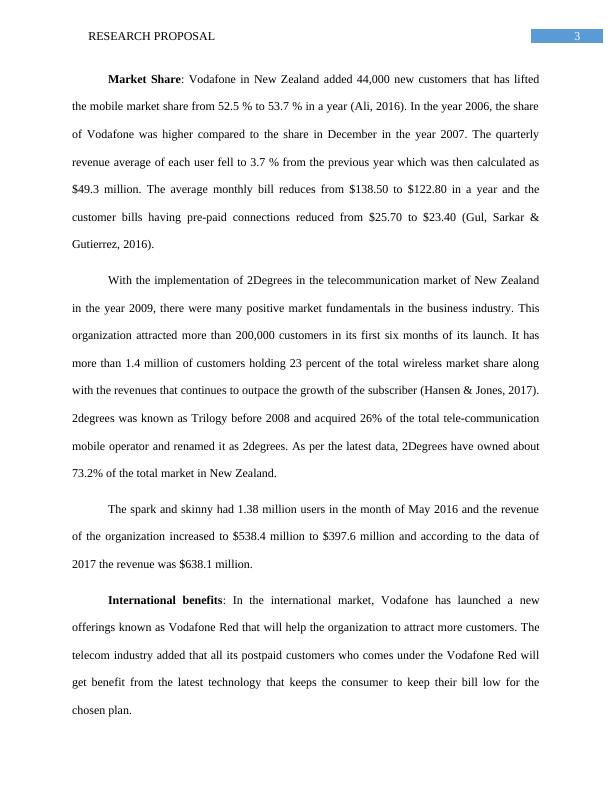
4RESEARCH PROPOSAL
The international benefit that 2Degrees provide is medical life insurance, phone plans for
the staffs, broadband as well as headsets at discounted rate (Mohanty & Das, 2018). The
organization also provides many roaming packs for its customers. There are monthly packs on
monthly basis, or weekly basis. The company provides roaming rates at very low cost.
The benefits of Spark and Skinny network is that it has 4G network all over the world
and has significantly lowered the cost of the mobile along with the roaming packs that were
available with the company.
Methods used for promotion: The Vodafone market aim in attaining the market
leadership, the network quality, as well as to maximize their customer satisfaction. The strategy
they use is to focus on their customer satisfaction and the product (MacMahon & Milner 2015).
The company is adopting many latest technology to develop their products and customer
services. The marketing strategy of Vodafone involved in changing its brand name from Hutch
to Vodafone and changing the tagline for the brand also.
For promoting its brand value, 2Degrees have incorporated free minute promotion, free-
text promotion, promotion involved in top up bonus, as well as promotions that are related to
value pack.
Spark and skinny encourages its customers with a tagline “Never Stop Starting”. This
company enhances its launching activities on Friday with a new retail brand that built in sharing
a Spark view point over the world.
Data plans: Vodafone offers data plans for 2GB data for 20o minutes with unlimited
texts. There are many data packs starting from 250 MB to 4GB starting from $14 to $49.
The international benefit that 2Degrees provide is medical life insurance, phone plans for
the staffs, broadband as well as headsets at discounted rate (Mohanty & Das, 2018). The
organization also provides many roaming packs for its customers. There are monthly packs on
monthly basis, or weekly basis. The company provides roaming rates at very low cost.
The benefits of Spark and Skinny network is that it has 4G network all over the world
and has significantly lowered the cost of the mobile along with the roaming packs that were
available with the company.
Methods used for promotion: The Vodafone market aim in attaining the market
leadership, the network quality, as well as to maximize their customer satisfaction. The strategy
they use is to focus on their customer satisfaction and the product (MacMahon & Milner 2015).
The company is adopting many latest technology to develop their products and customer
services. The marketing strategy of Vodafone involved in changing its brand name from Hutch
to Vodafone and changing the tagline for the brand also.
For promoting its brand value, 2Degrees have incorporated free minute promotion, free-
text promotion, promotion involved in top up bonus, as well as promotions that are related to
value pack.
Spark and skinny encourages its customers with a tagline “Never Stop Starting”. This
company enhances its launching activities on Friday with a new retail brand that built in sharing
a Spark view point over the world.
Data plans: Vodafone offers data plans for 2GB data for 20o minutes with unlimited
texts. There are many data packs starting from 250 MB to 4GB starting from $14 to $49.
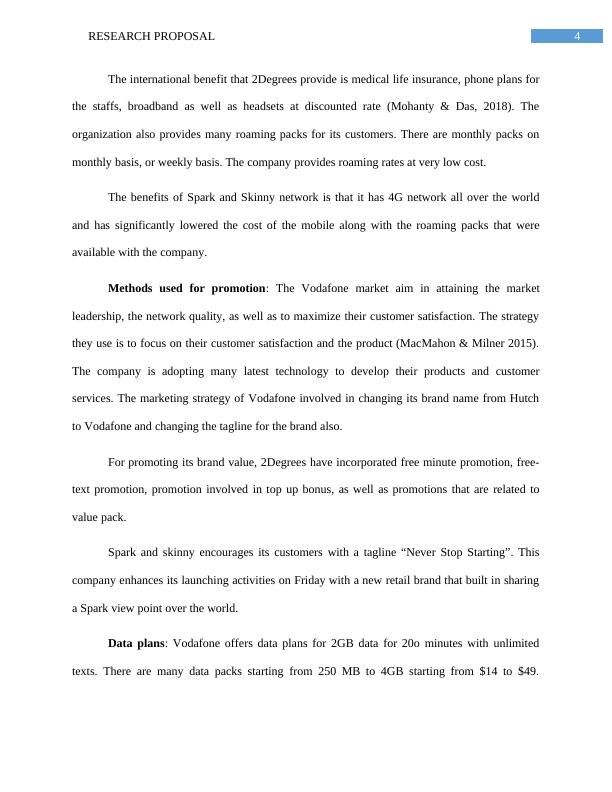
5RESEARCH PROPOSAL
2degrees also have various plans with different data and of different price. Customer can select
different plans according to their will.
Comparison: Spark is the largest company of telecommunication in New Zealand having
2.458 million customers using their mobile service with an increase of 2.8 % in the same year.
Comparing its sales rate with Vodafone, it has 2.578 million customers in the same year.
Vodafone in the year 2016 had only 428,000 customer using their broadband service while Spark
had 700,000 customers using the broadband service (Mohanty & Das, 2018). The 2degrees has
increased its profit which resulted as the third player in the telecommunication sector in New
Zealand. The share of Vodafone in the New Zealand is 60 % of the share in the telecom market
and Spark has about 37 % of the share. The total number of pre-paid customer in New Zealand is
lower compared to the post- paid customers which has increased the total number connection for
Vodafone.
3. Literature Review
Customer Retention in Telecommunication sector in New Zealand
According to Ascarza (2018), customer retention is defined as the most important
challenges that are faced by the company that provides service to customers. With the growth of
many competitive companies in the New Zealand market a telecommunication industry has to
face the challenges with customer retention. An integrated communication framework is to be
developed by the telecommunication sector which will provide more opportunities to the
customers by implementing new data resources as well as new methodologies like machine
learning. Moreover, the retention measurement is also an important part as mentioned in this
article. Several conditions are stated in the customer retention measurement such as inter-
2degrees also have various plans with different data and of different price. Customer can select
different plans according to their will.
Comparison: Spark is the largest company of telecommunication in New Zealand having
2.458 million customers using their mobile service with an increase of 2.8 % in the same year.
Comparing its sales rate with Vodafone, it has 2.578 million customers in the same year.
Vodafone in the year 2016 had only 428,000 customer using their broadband service while Spark
had 700,000 customers using the broadband service (Mohanty & Das, 2018). The 2degrees has
increased its profit which resulted as the third player in the telecommunication sector in New
Zealand. The share of Vodafone in the New Zealand is 60 % of the share in the telecom market
and Spark has about 37 % of the share. The total number of pre-paid customer in New Zealand is
lower compared to the post- paid customers which has increased the total number connection for
Vodafone.
3. Literature Review
Customer Retention in Telecommunication sector in New Zealand
According to Ascarza (2018), customer retention is defined as the most important
challenges that are faced by the company that provides service to customers. With the growth of
many competitive companies in the New Zealand market a telecommunication industry has to
face the challenges with customer retention. An integrated communication framework is to be
developed by the telecommunication sector which will provide more opportunities to the
customers by implementing new data resources as well as new methodologies like machine
learning. Moreover, the retention measurement is also an important part as mentioned in this
article. Several conditions are stated in the customer retention measurement such as inter-
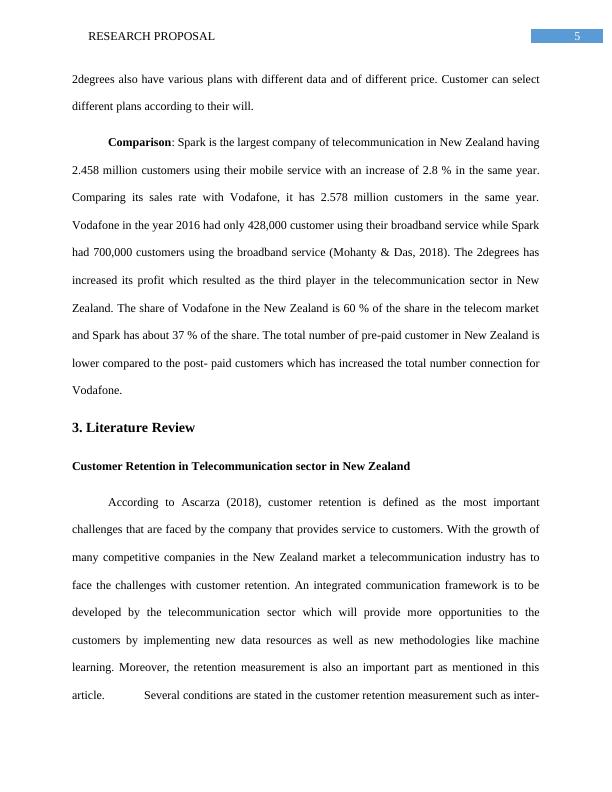
End of preview
Want to access all the pages? Upload your documents or become a member.
Related Documents
(Doc) Strategic Planning Solved Assignmentlg...
|16
|4989
|326
Etisalat Group: A Leading Telecom Company in UAElg...
|4
|1241
|52
Management of Economic: Vodafone: Mobile phone networklg...
|10
|2987
|64
Economics: Overview of the Telecommunications Industrylg...
|14
|3233
|12
Business, Society and the Planetlg...
|11
|3053
|277
Marketing Strategy of Vodafone: STP Analysis and Marketing Mixlg...
|17
|4372
|221
